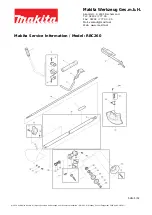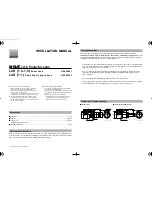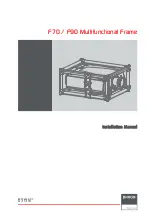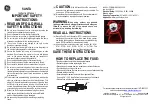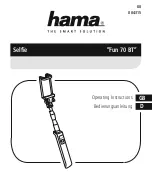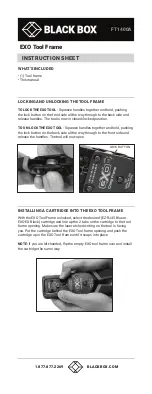
D-4
Rev 2.2, 10/31/94
two quantities, when discussing absolute signal levels, it is important to know what reference quantity
was used
:
De-Esser
A de-esser is a special type of
compressor
that operates only at high frequencies, usually
above 3 or 4 kHz. It is used, especially in the broadcast industry, to reduce the effect of vocal
sibilant
sounds, which are normally too strong when singers and announcers use very close-up microphones.
When the high-frequency energy exceeds a preset
threshold,
the compressor starts to operate to reduce
the high-frequency response. Low-level, high-frequency sounds are not reduced. (TAD)
The
601
uses a variation of this technique. The essential difference is that the threshold setting is
relative to the ratio of sibilant to non-sibilant sounds. The compressor operates across the entire audio
band; i.e. all signals are reduced in the presence of a sibilant sound that exceeds the preset threshold.
Digital
The application of digital computer-based technology to the recording and reproduction of music
is somewhat loosely called digital audio. (TAD)
Digital delay
A digital device which provides an adjustable time delay. Time delays are used in
artificial
reverberation
systems, for special echo effects in music recording, and to provide delayed sound
to certain loudspeakers in some sound reinforcement systems. Before the advent of digital delays, the
only the effect could be achieved was by tape
echo
, or by placing a loudspeaker at one of a long tube and
a microphone at the other. This gives a delay of about 1 millisecond per foot of length, and it becomes
bulky when long delays are needed.
Digital Signal Processing/DSP
The manipulation and modification of signals in the digital domain (after
having undergone analog-to-digital conversion). A great many electronic music instruments use DSP, as
do certain test equipment types such as the FFT analyzer. Most DSP devices have a microprocessor
inside them to do most of the work. (TAD)
The
601
uses two DSP 56001 digital signal processors and a 68HC11 microprocessor.
Digital to Analog Converter (DAC)
The component within a
digital
audio device which converts
binary digital words into an analog signal that can be amplified and sent to a loudspeaker, etc. The DAC
is the last link in the digital chain, just before the anti-imaging filter. (TAD)
See also:
analog to digital
converter
.
Distortion
Theoretically, any addition or modification to a signal caused by any type of equipment
could be called "distortion," but the term has come to be somewhat more restricted in its use. Distortion
may be conveniently grouped into six types
:
1.
Nonlinear distortion, manifested as harmonic distortion and intermodulation distortion. Harmonic
distortion is the production of harmonics of the original signal by the equipment. Intermodulation
distortion is the production of sum and difference products of the various frequency components
that make up an audio signal.
2.
Frequency distortion, the unequal amplification of different frequencies.
3.
Phase distortion, an effect caused when phase shift in an audio device is not a linear function of
frequency. In other words, different frequencies experience different time delays.
4.
Transient distortion, including transient intermodulation distortion (TIM).
5.
Scale distortion, or volume distortion.
6.
Frequency modulation distortion. Examples of this are flutter and wow, and doppler
distortion caused by the motion of loudspeaker cones. (TAD)
Downward Expander
See Expander.
Dynamic Filter
A dynamic filter is a type of single-pass noise reduction system that uses one or two
filters
whose cutoff frequencies are controlled by the level of the signal. As the signal level falls during soft
passages, the high-frequency response is reduced (like turning down the treble tone control), and when
the signal level is high, the full bandwidth is restored.
The effective operation of such a system depends on the fact that the noise will be masked by the signal
during loud passages, and this is true in many, but by no means all, cases.
A key element in the design of dynamic filters is the choice of time constants during the time that the
bandwidth is changing. If they are too fast, distortion results, and if too slow, the noise will be heard to
swish in and out as the signal level changes. (TAD)
Summary of Contents for 601
Page 46: ...4 18 Rev 2 2 10 31 94 This page is blank believe it or not ...
Page 48: ...4 20 Rev 2 2 10 31 94 Notes ...
Page 50: ...5 2 Rev 2 2 10 31 94 Notes ...
Page 70: ...7 16 Rev 2 2 10 31 94 Notes ...
Page 72: ...8 2 Rev 2 2 10 31 94 Notes ...
Page 74: ...9 2 Rev 2 2 10 31 94 Notes ...
Page 78: ...11 2 Rev 2 2 10 31 94 Notes ...
Page 126: ...D 12 Rev 2 2 10 31 94 Notes ...
Page 138: ...G 8 Rev 2 2 10 31 94 Notes ...































